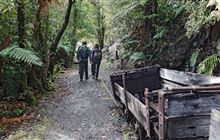History of Charming Creek
Introduction
Charming Creek is an outstanding example of the technological innovations by early timber millers and coal miners on the West Coast.The area boasts both stunning scenery and historical features.
Many remains of mining and timber milling history are found along the Charming Creek Walkways, which guide visitors along the route hardy workers braved during the 20th century.
Charming Creek is split into two unconnected walkways by an active slip – North and South.
Follow the North Walkway past the coal mine and both Watsons and Mumm’s Mills, through a historic tunnel to the spectacular Mangatini Waterfalls.
The South Walkway leads to Charming Creek’s transport and packing bins.
Image gallery
-
Diesel engine for hauling coal at Charming Creek in 1945. Ref: 1/4-001352-F, Alexander Turnbull Library. Image: John Pascoe | Creative Commons
![Black and white photo of a diesel train on the edge of a gorge. Black and white photo of a diesel train on the edge of a gorge.]()
-
Walker on the Charming Creek walkway Image: Baptiste Maryns ©
![Taken from within a hewn rock tunnel, a person is seen from behind stepping into the light of the tunnel entrance. Taken from within a hewn rock tunnel, a person is seen from behind stepping into the light of the tunnel entrance.]()
-
Mangatini Falls Image: James Gibson | Creative Commons
![A small waterfall shines in the sun as it flows into a still pool. A small waterfall shines in the sun as it flows into a still pool.]()
Charming Creek is one of the most intact sawmill and coal mining landscapes in New Zealand.
The entrepreneurial spirit of the West Coast is obvious in the Charming Creek Coal Mine, a private enterprise that opened in 1927 at a time when most coal mines were state owned.
Its tramway pushed bush tram engineering to its limits at the time of construction. It transported timber and then later coal.
Workers also rode the tramway. They had to brave the perilous ride down the gorge prior to the building of the road from Seddonville. Charming Creek’s treacherous tramway wasn’t called a “hellhole of a place” for no reason.
The heritage features of Charming Creek are testament to the ingenuity required to extract timber and coal from a rugged landscape.
Beyond gold
Industry on the West Coast was initially driven by gold, with miners flocking to the region through the 1860s. Timber milling began as a means to support the gold industry.
When coal became king on the West Coast, timber was key to the new transport and mining infrastructure. In 1906 millworker Robert Watson had established a small sawmill above Charming Creek and work began at Charming Creek Coal Mine in 1927.
Harsh conditions
Work and travel conditions at Charming Creek were poor and occasionally fatal. Workers were at the frontline of the labour and union movement.
Mine operators tried to introduce the controversial ‘tribute’ system where miners took responsibility for working an area, then sold to the mining company for a fixed price. This undermined the collective agreement and often led to unsafe practices. The Charming Creek miners became the first in the country to oppose this system, although it became a widespread practice throughout the country.
All things end eventually
During the 1940s the Charming Creek coal mine grew to become one of the largest private mines in the country. However the aftermath of the Great Depression saw employment levels plummet and the demand for coal reduced as the shipping trade gradually switched its fleet to run on oil.
Hydraulic mining in the 1950s helped the mine survive but the region’s coal was slowly banned in many schools, hospitals and cities due to its high sulphur content.
The tramway closed in 1958 after the Seddonville road was built. The nearby rail line closed in 1981. Operations ended on 1 May 1986, making Charming Creek one of New Zealand’s longest-operating mines.
Further reading
Charming Creek tramway: milling | mining | walkway — a history (PDF, 6,840K)





